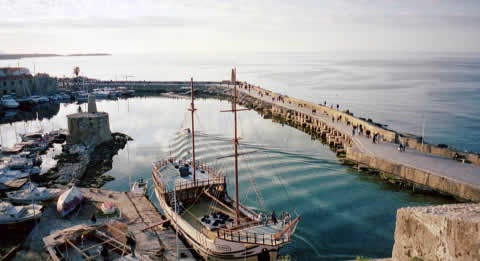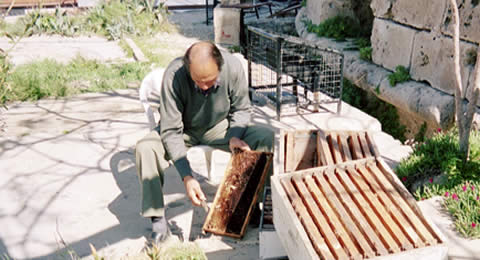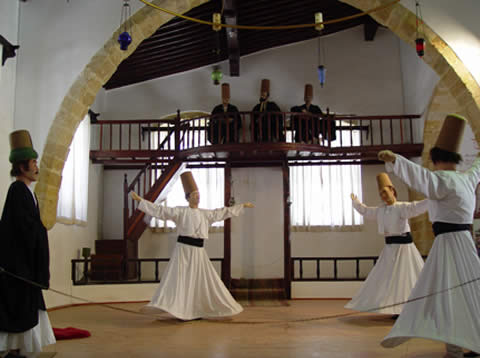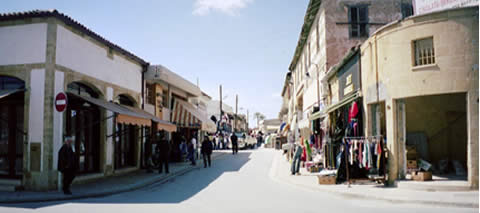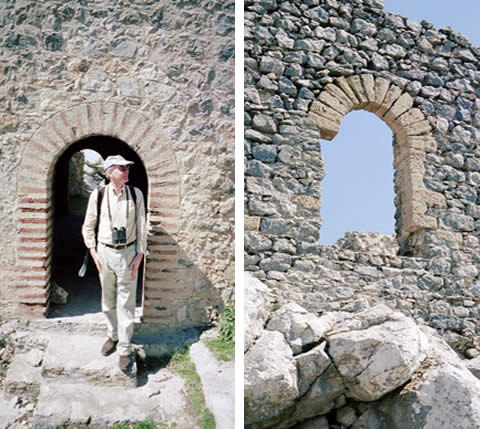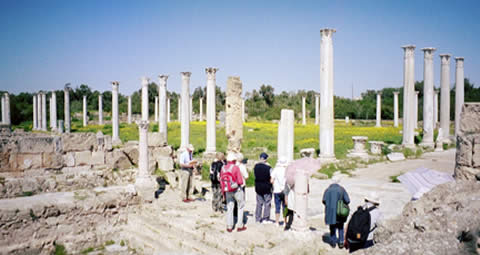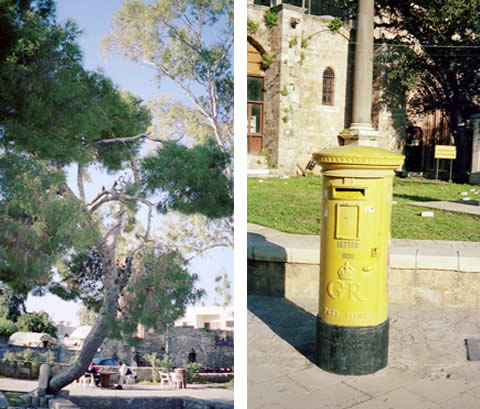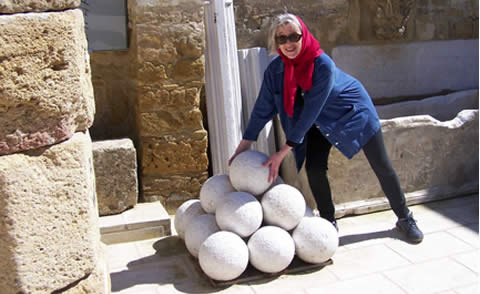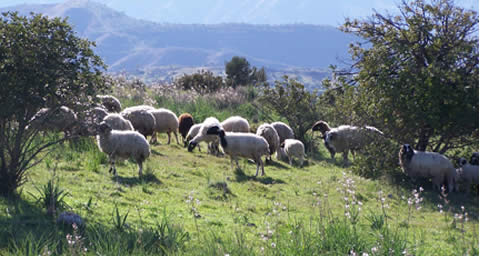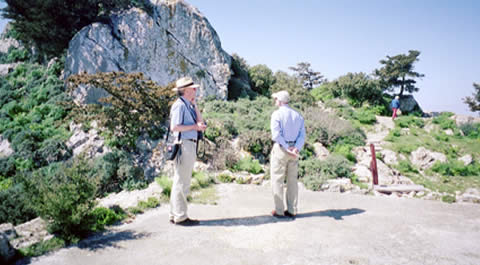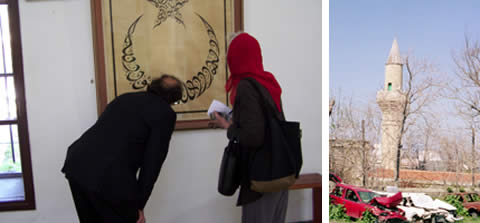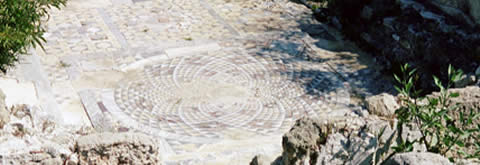Cyprus. Not a number one choice for me, but John had talked about revisiting his childhood haunts there since I met him in 1968, so when I saw Northern Cyprus scheduled for early March in the ACE brochure, including many castles, I thought I would make it happen.
The tour leader is Curator of the British Architectural Library at the V & A museum. That sounded good, too, and when I managed to book the last two places, I was cautiously optimistic. John was thrilled.
The interminable queue at Heathrow for Turkish Cypriot airlines began to cast doubts. I whiled away time trying to guess who our companions might be. Then we came upon somebody we hadn’t seen for almost 30 years, who used to work at the Ministry of Defence with John’s father. An amazing, welcome coincidence.
When we finally climbed down onto the tarmac at Ercan airport it was past midnight. The faint smell of mimosa on the cool night breeze made me sniff the air like a wild animal, taking stock.
We are staying at the Dome Hotel, (shades of Lawrence Durrell), in Kyrenia. Room 404. We are so near the sea that, were I to fall from the balcony, it would be straight into the water. But, instead, I fall into bed and am asleep as my head touches the pillow.
Day 1
Wake up to blue sky and sunshine with the castle of St. Hilarion in full view from our balcony. I track down cherry and mandarin juice at breakfast. Lots of food but I opt for yoghourt, figs and carob syrup. There is a tempting sponge cake, elliptically shaped like a flying saucer and soaked in honey with cream inside. My sweet tooth manages to resist – just. Instead, I concentrate on the Turkish waiters who bring us coffee with wild-eyed flourishes.
At midday, we are whisked off to Bellepais abbey, set in a small, verdant, tranquil village on a hill, overlooking Kyrenia. Tall cypresses guard the abbey ruins and there is that ‘out of time’ feeling, intensified by the humming of bees. They are cruising above the swathes of Bermuda buttercups, reminding me of the beekeeper we met this morning, cleaning out the frames of his beehives under the castle walls in Kyrenia.
This morning we had strolled along the stone jetty which curls around the harbour and out to sea. The monumental castle walls dominate the entrance, flags flying. A group of Turkish boys were swimming. Boats, large and small, old and new, one being built, made for a busy and picturesque harbour scene with the old houses and waterside restaurants curved around the water in a horseshoe shape.
The downside was the amount of tins and bottles floating around and some communistic bloc(k) style monuments, whose angular and unappealing pools were home to plastic bags. A dismal scene but easy to clean up and replace I would have thought.
Later, we returned to explore the castle inside. The ramparts abound with giant fennel and asphodel and Charles, our guide, fills us in on the very bloody history as we watch the sunset turning the sky a film set golden pink over St. Hilarion, finally staining it deep red as it drops behind the horizon. I think of Eric Rohmer’s film ‘Le Rayon Vert’. Tomorrow it will be ‘The Green Line’ in Nicosia.
Before supper, Charles gives us a talk about the history of Cyprus and our itinerary for the next few days. We are now sitting at a long conference table on chairs swathed in white with apricot silk bows. Set up for a U.N. conference, taking place tomorrow. I doubt they will get complimentary ‘brandy sours’ like us, which are much appreciated.
Day 2
Early start, as we are off to Nicosia. ‘I am happy to be a Turk’ is emblazoned (in English) on a banner strung across the road as we approach the city. Charles points out the ‘Green Line’, beyond which is the Greek part of the island. It consists of a double row of white barrels, which seem to snake in and out, past pockmarked buildings and the bottom of peoples’ gardens. They remind me of old recycled barrels that people use as water butts on their allotments. John says they are oil barrels. Some of the streets in the city are closed off at one end with high wooden gates.
We have coffee in the pretty internal open courtyard of the Arts and Crafts centre, which John remembers as having been a prison. I am beguiled by the Whirling Dervishes museum: a calm, harmonious space with a small garden filled with white blossom, high walls protecting it from the busy street outside.
The cathedral, now a mosque, is deeply carpeted in salmon pink and we take off our shoes before entering. The sweat from my stockinged feet on the stone flags makes perfect footprints. The essence of my DNA has sunk and faded invisibly, in seconds, into the stone and so part of me is there ‘forever’, whether I like it or not. Inside, the carpet is soft and yielding and I fight the urge to lie down on it. We then leave to buy halva and Turkish delight, directed to the best shops by Senol, our Turkish Cypriot guardian and guide.
Outside another small mosque, someone has thrown a red and blue patterned carpet over the graveyard wall and in its folds, suspended hammock-like, a tabby cat luxuriates, fixing us with an impassive stare.
In a church, almost dead from war damage and neglect, its skeleton propped up with scaffolding, John pointed out a graffito on the wall and asked me what I thought it resembled. To me, it looked like a water jar. But no, it was a grenade. An example of how misinterpretation can cause so many ongoing problems.
On the way home, we pass endless casinos and nightclubs with English names, e.g. Lipstick Nightclub, Sexy Lady Nightclub, Galaxy Casino, Casino Rocks and I wonder how they survive, there are so many cheek by jowl. I don’t think that’s a question for Charles but maybe Senol will fill me in.
Day 3
I notice that the elaborate chandeliers in the hotel dining room are doing a balancing act as all the wiring is sticking out somewhat alarmingly from holes in the ceiling. Today we are off to Buffavento castle. It’s a long, steep climb up many steps but the weather is perfect and the path edged with blue pimpernels which resemble small, sparkling jewels, presented on green tussocky cushions. At the top we have eagle eye views of the island and the ruins themselves are very atmospheric. Barrie takes an ‘exclusive’ photo of us all being kings and queens of the castle at the top.
Meanwhile, Senol has prepared a picnic for us under the trees below. Then a walk through the woods leads us to a Herbarium, where we identify a lot of the wild flowers we’ve seen. Further on, we arrive at a ruined Armenian monastery, set in a deep valley. There’s a tree, heavily laden with oranges, at the entrance. There is also mandrake, a poisonous plant whose root can look like a human figure and is said to shriek when pulled out of the ground. It was once used as a narcotic and anaesthetic and for treating snakebites. Low lying, with blue grey rosettes of leaves and heavy, slightly hairy, dowager blue flowers at the centre. It looks slightly sinister, as do the many spent shotgun cartridges littering the ruins. There don’t seem to be many birds. But the setting is glorious and the sense of history has entered my veins.
Day 4
We are up and away by 8.30 a.m. I love the monastery garden at SS Paul and Barnabas. Martins are swooping here and there and we stand under a great tree shading a small square of blue, red and cream flowers in front of the entrance to the chapel. There is a desiccated cactus in an impossibly small pot, which has managed to creep up the wall all the way to the roof. Unbelievably enduring and resilient – as many of the poverty stricken people who live here continue to be. As I get onto the bus, I buy half a kilo of rough, white sugared almonds from a woman eking out a living from a makeshift stall.
Salamis is an archaeological site that everyone who goes to Cyprus should visit. Today, the mosaics and pillars and headless robed statues are enveloped in waves of yellow daisies and oceans of soft and bouncy fennel stretch away to the water’s edge. Barrie – he of the fez, bought in Nicosia – and I, miss a bit of Charles’s commentary as we are watching giant, foot long, dragon lizards with ridged backs peering out of large cracks in the blocks of stone. Hypnotic. Back at the bus, Senol is handing out juicy, fresh oranges and tangerines, brought from his own garden. I am feeling so footloose and fancy free. I think this is partly because I have no responsibilities and at the same time we are being so well looked after every step of the way – just so relaxing.
Lunch is in view of the sea at Famagusta. For some reason, Senol then takes us to a modern, five star beach hotel. I realise why when he points to a flag about fifty yards down the beach where similar buildings abound but no people. It is No Man’s Land, occupied by the military. Definitely a ‘no go’ area, unless you have decided to ‘end it all’, in which case it will, presumably, be effectively handled for you. The central square in Famagusta is pedestrian only (bar the odd rogue motor scooter). It is partly shaded by very old, tall, elegant trees. There is also a George VI ‘red’ pillar box, except it is painted yellow. John’s mother later tells me that they were all painted blue (in defiance of the British) in the fifties.
The ruins of the castle overlook the docks. It is impressive and standing on the ramparts I see the spirit of John’s father’s pale blue Jaguar being lifted by a crane into the boat, which would take them from Cyprus to the mainland and the long drive home to England.
We end up in a wonderful café, sitting by a central fountain, where small turtles and goldfish swim in a blue mosaic patterned pool. We order Turkish delight and it’s so more-ish that we end up buying boxes of it from a grand array on sale. For years I thought the phrase was ‘Moorish’, which conjured up pictures of bejewelled, flowing robes, secrets of the harem, sherbets and sweetmeats. I shall continue to spell it that way.
On the way to bed I feel my wrist throbbing. Disaster. It is inflamed and swollen. Luckily, I have my ‘splinter’ tweezers with me. I manage successful surgery but it takes me almost thirty minutes and when I finally emerge from the bathroom, John is asleep. Tomorrow, it’s St. Hilarion, the focus for John’s trip in the first place. When we went to Syria, the equivalent was Krak des Chevaliers. We nearly missed that because I was taken ill and only a mouse squeak from hospital. Can disaster strike so specifically once again? Well, yes, I’m sure it can but I have hopefully managed to thwart it. I fall asleep to the sound of the sea.
Day 5
Blue skies and sunshine prevail. We could call ourselves the lucky 21 club, that being the number in our group. St. Hilarion is a real fairytale castle, growing out of the rock with the jousting ground set out in front, part of it now a rifle range. Plus que ca change, plus que c’est la meme chose. The castle is on many levels, like a hill top village. The most impressive part for me is the royal apartments. The views and elegant proportion of the rooms puts it on a par with the ultimate penthouse suite by today’s standards.
360-degree views of the island from the topmost point just speak of mega power driven crusader knights. On the way down we pass a mysterious cistern, full of green and froggy water. Then we drink homemade orange juice made by the guardian of the site and buy a jar of carob syrup. I hope we get it home in one piece! The driver has parked our bus with three feet of its back end over a steep drop so Barrie is sitting on thin air. I avert my eyes until the bus moves off safely.
Next stop, St. Mammas monastery, ablaze with icons, carvings and delicately engraved sanctuary lamps. There are also wax effigies of babies, ears and limbs by a sarcophagus, which apparently has healing powers. A brownish looking liquid seeps out of the bottom of it. I prefer the holy men riding on lions in the paintings. Senol gives us special dispensation to enter the ‘male’ sanctuary. It promises much but is rather basic on the other side of the elaborate façade and needs a good dusting.
Next door is a museum with many ‘died’ animals, among them eight legged lambs and horribly viscous, preserved, poisonous snakes coiled up in jars. Upstairs is a many-breasted statue of a fertility goddess? I remember seeing one at Fontainebleau too. Fascinating, but I am content with two breasts myself.
The palace of Vouni looking out to sea from its cliff top is a welcome antidote. I can imagine being a princess spending my summers here. Lots of large, heavy bodied cicadas and pretty butterflies. I peer down the grid-covered cisterns and muse about whether they all join together into a large, underground reservoir.
It’s good to get back to the Dome. Am tired but also fired up by all we have seen and go off to track down a ‘brandy sour’ before dinner.
Day 6
Last day. It’s a 7.30 a.m. breakfast and then off to our fifth castle. Kantara. It’s a long, slow haul in the bus up narrow, winding tracks over steep drops. Luckily, I am not on that side of the bus today. Instead, I am studying the wild flower book Senol brought for us.
To date we have seen anemones, asphodel, blue pimpernels, Bermuda buttercups, cyclamen, giant fennel, iris, mandrake, narcissi, poppies, yellow daisies and almond and cherry blossom along with smaller alpines. I have pressed a few in my book. I thought I would like to press one or two of my companions as well, so I could take them out from time to time for a chat. I have enjoyed meeting all these new people.
The castle is breathtaking, strung out along the mountain top in a way which reminds me of Peyrepertuse, a Cathar castle in south west France. In six weeks or so all this green landscape will be dry and brown with temperatures in high summer approaching 50 degrees centigrade.
John and I explore all the anterooms along the cliff top to the annoyance of nesting birds, until we come upon a cistern, hidden in the last room. It would be easy to fall into if you’re not taking care as you enter the darkness out of the blinding sunlight. It’s quite a way down to the deep, clear water. Cool and pleasant.
Charles told us that last year an over enthusiastic member of the group did fall into a cistern and ripped his trousers in an awkward place. The waiter at the restaurant lent him a pair over lunchtime while his own were spirited away to be mended and cleaned before the bus left. This could serve as an example of how we’ve been treated all week. Nothing has been too much trouble. Conversely, none of us has fallen down a cliff or into the sea. There’s still time though.
After Kantara we have a pit stop. Senol has prepared elevenses, which include some crunchy biscuits rolled in sesame seed. We have them with red wine and raki. Our next stop is the Panhandle, a long strip of land at the north east corner of the island, where there are turtles, donkeys and ruined monasteries. Lunch is at a simple fish restaurant by the sea, built out over the rocks. We then go on to see a small ruined basilica overlooking the sea and come upon more dragon lizards. John takes a wonderful photo of them with the moon behind. The next stop is an archaeological site which is only partly uncovered, where there are weather worn mosaics, including a picture of a pair of sandals. Kind of domestic and nostalgic. Small girls bring us bunches of flowers. An idyllic scene but I think a bit of money changing hands enters the equation somewhere. However, this is not allowed.
The last supper is at the sophisticated Bellepais Gardens Hotel. The choice of restaurants has been very good. I think this may have been Senol’s brief. I have collected money from the rest of the group to give tips to both Senol and our driver. Sir Robert, a retired government private secretary, does the honours and presents the envelopes after dinner. I hope they are full of enough money to make a worthwhile tip. I didn’t count it.
Homeward bound
And so we’re all packed and ready to go at 7.30 a.m. We are shepherded for the last time by Charles and Senol into Ercan airport, named after a pilot who was killed by EOKA terrorists in 1974. I don’t like goodbyes and am aware that the camaraderie that has gradually built up between us during this week of being 12+ hours together every day is about to fall apart and be lost as we return to our daily lives. It has been a hugely enjoyable and unforgettable week.
I don’t know how the differences can be smoothed out in Cyprus but I do hope some sort of balance can be achieved so that Turks and Greeks can live together peaceably. In Northern Cyprus, tourism and real estate are seen as up and coming money-spinners but I am not sure if it is the best thing to rely on. It would be disastrous, for example, if Kyrenia were unwittingly to host guests of the type who descend into drunken brawling.
If trade embargos were lifted, at least it would help people to get back to living lives of opportunity. For instance, the citrus groves could be properly harvested. It is a land sorely in need of sustainable development and expertise in planning this.
There is also an enormous water problem. Not enough water on the island means that some has to be brought by tanker from Turkey. We saw a huge orange-red balloon collapsed and floating on the sea yesterday. Senol pointed out that it had been full of fresh water but had not managed to make the trip across. (Was it dragged behind a tanker? I don’t know). A low water table also means that seawater begins to seep into the aquifers, causing disruption to agriculture.
We were shown much kindness and hospitality by people here, who have needed endless resilience and perseverance to survive. I hope a better future lies in store for them, although the bitter feuding is entrenched and needs something radical to happen to put it into some sort of perspective. I suspect there is no easy answer.
The End

